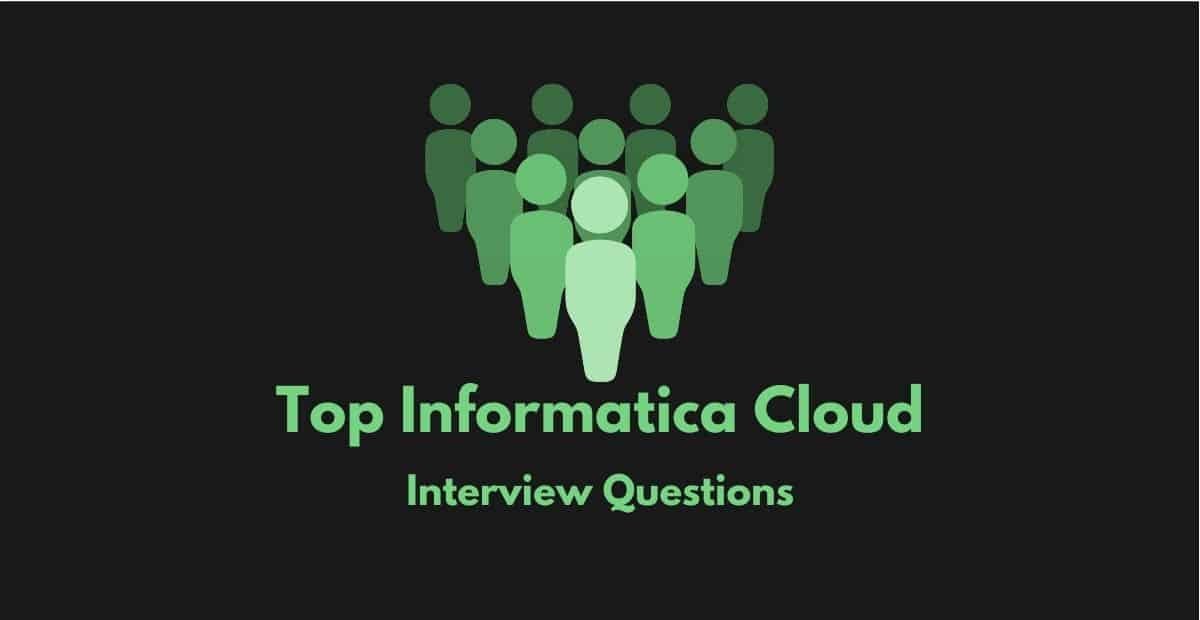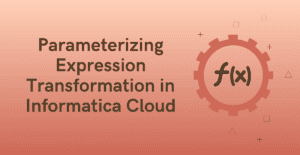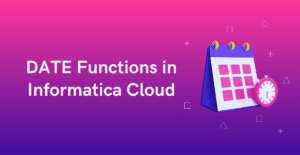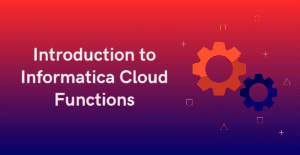1. What is the difference between Informatica Powercenter and Informatica Cloud?
Informatica Intelligent Cloud Services is a cloud based Integration platform(iPaaS). IICS helps you integrate, synchronize all data and applications residing on your on-premise and cloud environments. It provides similar functionality as Powercenter in a better way and can be accessed via the internet. Hence in IICS, there is no need to install any client applications on the Personal computer or server. All the supported applications can be accessed from the browser and the tasks can be developed through browser UI. In Powercenter, the client applications need to be installed on your server.
2. What is a Runtime environment?
A Runtime environment is the execution platform that runs a data integration or application integration tasks. You must have at least one runtime environment setup to run tasks in your organization. Basically it is the sever upon which your data gets staged while processing. You can choose either to process via the Informatica servers or your local servers which stays behind your firewall. Informatica supports following runtime environments- Informatica Cloud Hosted Agent, Serverless runtime environment and Informatica Cloud Secure Agent.
3. What is a Synchronization task?
Synchronization task helps you synchronize data between a source and target. A Synchronization task can be built easily from the IICS UI by selecting the source and target without use of any transformations like in mappings. You can also use expressions to transform the data according to your business logic or use data filters to filter data before writing it to targets and use lookup data from other objects and fetch a value. Anyone without Powercenter mapping and transformation knowledge can easily build synchronization tasks as UI guides you step by step.
4. What is a Replication task?
A Replication task allows you to replicate data from a database table or an on-premise application to a desired target. You can choose to replicate all the source rows or the rows that changes since the last runtime of the task using built in Incremental processing mechanism of Replication Task.
You can choose from three different type of operations when you replicate data to a target.
→ Incremental load after initial full load
→ Incremental load after initial partial load
→ Full load each run
5. What is the difference between a Synchronization task and Replication task?
One of the major differences between a Synchronization task and a Replication task is that, in a synchronization task, you can transform the data before loading it to the target. However, in a Replication task, you can replicate the data from source to target without transforming the data.
A Replication task can replicate an entire schema and all the tables in it at a time which is not possible in Synchronization task.
A Replication task comes with a built-in incremental processing mechanism. In Synchronization task user needs to handle the incremental data processing.
6. Where does the metadata of tasks gets stored in Informatica Cloud (IICS)?
All the metadata gets stored in the Informatica Cloud repository. Unlike Powercenter, all the information in Informatica Cloud is stored on the server maintained by the Informatica and the user does not have access to the repository database. Hence, it is not possible to use any SQL query on metadata tables to retrieve the information like in Informatica Powercenter.
7. What metadata information gets stored in the Informatica Cloud (IICS) repository?
Informatica Cloud Services includes the IICS repository that stores various information about tasks. As you create, schedule, and run tasks, all the metadata information is written to IICS repository.
The various information that gets stored to IICS repository include:
Source and Target Metadata: Metadata information of each source and target including the field names, datatype, precision ,scale and other properties.
Connection Information: The connection information to connect specific source and target systems in an encrypted format.
Mappings: All the Data integration tasks built, their dependences and rules are stored.
Schedules: The schedules created you run the task built in IICS are stored.
Logging and Monitoring information: The results of all the jobs are stored.
8. What is a Mapping Configuration task?
A Mapping Configuration Task or Mapping Task is analogous to a session in Informatica Powercenter. When you create a Mapping Task, you must select a mapping to use in the task. Mapping task allows you to process data based on the data flow logic defined in a mapping.
Optionally, you can define the following in the Mapping Task
→ You can define parameters that associate with the mapping.
→ Define pre and post-processing commands.
→ Add advance session properties to boost the performance.
→ Configure the task to run on schedule.
9. What is a taskflow in Informatica Cloud?
A Taskflow is analogous to a workflow in Informatica Powercenter. A taskflow controls the execution sequence of a mapping configuration task or a synchronization task based on the output of the previous task. To create a taskflow, you must first create the tasks and then add them to a taskflow.
The taskflow allows you to
→ Run the tasks sequentially
→ Run the tasks in parallel
→ Make decisions based on outcome from one task before triggering the next task.
10. What is the difference between a Taskflow and Linear Taskflow?
A Linear taskflow is a simplified version of the Data Integration taskflow. A linear taskflow groups multiple Data Integration tasks and runs them serially in the specified order. If a task defined in Linear taskflow gets failed, you need to restart the entire taskflow. However, a taskflow allows you to run the tasks in parallel, provides advanced decision making capabilities and allows you to either restart from failed task or skip it when a task fails.
11. Can we run Powercenter jobs in Informatica cloud?
Yes. There is a Powercenter task available in Informatica Cloud where in user have to upload the XML file exported from Powercenter in Data Integration and run the job as a Powercenter task. You can update an existing PowerCenter task to use a different PowerCenter XML file but cannot make changes to an imported XML. When you upload a new PowerCenter XML file to an existing PowerCenter task, the PowerCenter task deletes the old XML file and updates the PowerCenter task definition based on new XML file content.
12. How does an Update Strategy transformation work in Informatica Cloud?
There is no Update strategy transformation available in Information Cloud. In the target transformation in a mapping, Informatica Cloud Data Integration provides the option for the action to be performed on the target – Insert, Update, Upsert, Delete and Data Driven.
13. What is Flow Run Order in Informatica Cloud?
When there are individual data flows in a mapping, the order in which the data integration process the flows can be configured in Informatica Cloud Data Integration using Flow Run Order. This is analogous to the Target Load Plan in the Informatica Powercenter.
A flow is a collection of all connected sources, transformations and targets in a mapping. You can have multiple flows in a mapping. Specify the flow run order when you want Data Integration to load the targets in different flows in the mapping in a particular order.
14. What is Dynamic Linking?
Informatica Cloud Data Integration allows you to create a new target files/tables at runtime. To use this feature in mappings, choose Create New at Runtime option in target and specify the name for the new target.
The user can choose a static filename where the target file will be replaced by a new file every time the mapping runs. The user can also choose to create a Dynamic filename so that the every time the mapping runs, target file is created with a new name.
15. In what format can you export a task present in Informatica Cloud?
Informatica Cloud Data Integration supports exporting the tasks as a zip file where the metadata gets stored in the JSON format inside the zip file. However you can also download a XML version of the tasks also which can be imported as workflows in Powercenter. But it will not support bulk export of tasks in XML format at a time. Where as you can export multiple tasks in form of JSON in a single export zip file.
16. How do you read JSON Source file in IICS?
JSON files are read using the Hierarchy Parser transformation present in IICS. The user needs to define a Hierarchical Schema that defines the expected hierarchy of the JSON file. The Hierarchical Schema can then be imported into Hierarchy Parser transformation while reading the data from input JSON files which converts the input based on the schema that is associated with the transformation. The Hierarchy Parser Transformation can also be used to read XML files in Informatica Cloud Data Integration
17. What is a Hierarchical Schema in IICS?
A Hierarchical Schema is a component where user can upload an XML or JSON sample file that define the hierarchy of output data. The Hierarchy Parser transformation converts input based on the Hierarchical schema that is associated with the transformation.
18. What is Indirect File loading and how to perform Indirect loading in IICS?
The ability to process multiple source files of same structure and properties through a single source transformation in a mapping is called Indirect File Loading. In order to perform Indirect loading in IICS, prepare a flat file which holds the information of all source filenames which share same file structure and properties. Pass this file as source file and select the File List under Source Type property of a source transformation in a mapping. The data from all the files listed in the source file will be processed in a single run.
19. What are the parameter types available in the Informatica Cloud?
You can add parameters to mappings to create flexible mapping templates that developers can use to create multiple mapping configuration tasks. IICS supports two types of parameters.
Input Parameter: Similar to a parameter in Powercenter. You can define an input parameter in a mapping and set the value of the parameter when you configure a mapping task. The parameter value remains constant as the value defined in mapping task or a Parameter file through out the session run.
In-Out Parameter: Similar to a variable in Powercenter. Unlike input parameters, an In-Out parameter can change each time a task runs. When you define an In-Out parameter, you can set a default value in the mapping. However, you would typically change the value of In-Out Parameter at run time using an Expression transformation using SETVARIABLE functions. The mapping saves the latest value of the parameter after the successful completion of the task. So, when the task runs again, the mapping task compares the In-Out parameter to the saved value instead of default value.
20. How many Status states are available in IICS monitor?
The various status states available in IICS are
Starting: Indicates that the task is starting.
Queued: There is a predefined number set which controls how many tasks can run together in your IICS org. If the value is set to two and if two jobs are already running, the third task you trigger enters into Queued state.
Running: The job enters the Running status from Queued status once the task is triggered completely.
Success: The task completed successfully without any issues.
Warning: The task completed with some rejects.
Failed: The task failed due to some issue.
Stopped: The parent job has stopped running, so the subtask cannot start. Applies to subtasks of replication task instances.
Aborted: The job was aborted. Applies to file ingestion task instances.
Suspended: The job is paused. Applies to taskflow instances.
21. How to invoke Informatica Cloud tasks based on a file event?
To capture a file event and trigger tasks based on that event, Informatica Cloud provides a component called File Listener. A File Listener listens to files on a defined location. You define a file listener that listens to a specific folder and the file pattern. A file event is detected when new files arrive to the monitored folder or the files in the monitored folder are updated or deleted.
22. To include all incoming fields from an upstream transformation except those with dates, what should you do?
Configure two field rules in a transformation. First, use the All Fields rule to include all the fields coming from upstream transformation. Then, create a Fields by Datatypes rule to exclude fields by data type and select Date/Time as the data type to exclude from incoming fields.
23. What are Preprocessing and Postprocessing commands in IICS?
The Preprocessing and postprocessing commands are available in the Schedule tab of tasks to perform additional jobs using SQL commands or Operating system commands. The task runs preprocessing commands before it reads the source. It runs postprocessing commands after it writes to the target. The task fails if If any command in the preprocessing or postprocessing scripts fail.
24. What are Field Name conflicts in IICS and how can they be resolved?
When there are fields with same name coming from different transformations into a downstream transformation like a Joiner transformation, the cloud mapping designer generates a Field Name Conflict error. You can either resolve the conflict by renaming the fields in the upstream transformation only or you can create a field rule in downstream transformation to Bulk Rename fields by adding a prefix or a suffix to all incoming fields.
25. What system variables are available in IICS to perform Incremental Loading?
IICS provides access to following system variables which can be used as a data filter variables to filter newly inserted or updated records.
$LastRunTime returns the last time when the task ran successfully.
$LastRunDate returns only the last date on which the task ran successfully. The values of $LastRunDate and $Lastruntime get stored in Informatica Cloud repository/server and it is not possible to override the values of these parameters. These parameters store the datetime value in UTC time zone.
26. What is the difference between the connected and unconnected sequence generator transformation in Informatica Cloud Data Integration?
Sequence generator can be used in two different ways in Informatica cloud. One with Incoming fields disabled and the other with incoming fields not disabled.
The difference between the sequence generator with incoming fields enabled and disabled is, when NEXTVAL field is mapped to multiple transformations,
→ Sequence generator with incoming fields not disabled will generate same sequence of numbers for each downstream transformation.
→ Sequence generator with incoming fields disabled will generate Unique sequence of numbers for each downstream transformation.
27. Explain Partitioning in Informatica Cloud Data Integration.
Partitioning is nothing but enabling the parallel processing of the data through separate pipelines. With the Partitioning enabled, you can select the number of partitions for the mapping. The DTM process then creates a reader thread, transformation thread and writer thread for each partition allowing the data to be processed concurrently, thereby reducing the execution time of the task. Partitions can be enabled by configuring the Source transformation in mapping designer.
There are two major partitioning methods supported in Informatica Cloud Data Integration.
1. Key Range Partitioning distributes the data into multiple partitions based on the partitioning key selected and range of the values defined for it. You must select a field as a partitioning key and defined the start and end ranges of the value.
2. Fixed Partitioning can be enabled for sources which are not relational or support key range partitioning. You must select the number of partitions by passing a value.
28. How to pass data from one mapping to other in Informatica Cloud Data Integration?
The data can be passed from one Mapping task to another in Informatica Cloud Data Integration through a Task flow using parameters. The Mapping Task which passes the data should have an In-Out Parameter defined using SetVariable functions. The Mapping Task which receives the data should either have an Input parameter or an In-Out Parameter defined in the mapping to read the data passed from upstream task.
29. What is Informatica Cloud Secure Agent?
Informatica Cloud Secure Agent is a light weight, self-upgrading program that you need to install in your server and register it with Informatica Cloud repository using the unique registration code provided for your organization account. It runs all tasks and enables secure communication across the firewall between your organization and Informatica Intelligent Cloud Services.
30. What are Secure Agent Groups?
By default after you install and register an Informatica Cloud Secure Agent, a Secure Agent Group is created and the installed Secure Agent is added under that group. All the secure agent groups created in the Org can viewed from the Runtime Environments page of Administrator Service.
You can either create a new secure agent group and add multiple secure agents under it or add new secure agents in the existing secure agent group.
31. What are the advantages of creating multiple secure agent groups?
Prevent the activities of one department from affecting another department:
For example, if there are multiple teams working under a single IICS org, create separate Secure Agent groups for each department. So the tasks run by one department will not be impacted by tasks run by another department.
Separate tasks by environment:
You can create different Secure Agent groups for test, acceptance and production environments. When you configure a connection, you can associate it with the test, acceptance or production database by choosing the appropriate Secure Agent group as the runtime environment.
32. What are the advantages of secure agent group with multiple agents?
Load Balancing – Balance the workload across machines:
Add multiple agents to a group to balance the distribution of tasks across machines. When the runtime environment is a Secure Agent group with multiple agents, the execution of tasks will be distributed to various agents in the agent group in round-robin fashion automatically. It’s not possible to override the task assignment and the agent gets assigned in round-robin fashion automatically.
High Availability – Improve scalability for connections and tasks:
When you create a connection or task, you select the runtime environment to use. If the runtime environment is a Secure Agent group with multiple agents, the tasks can run if any Secure Agent in the group is up and running. You do not need to change connection or task properties when you add or remove an agent or if an agent in the group stops running.
33. Explain what is Pushdown Optimization in Informatica Cloud?
Pushdown Optimization is a performance tuning technique where the transformation logic is converted into SQL and pushed towards either source database or target database or both. The amount of data transformation logic that can be pushed to the database depends on the database type, transformation logic, mapping task configuration.
Processing data on database level is much faster and efficient compared to processing the data in Informatica and Pushdown Optimization helps in achieving this in Informatica Cloud. Informatica processes all transformation logic at Informatica level that it cannot push to a database.
34. What is a Dynamic Mapping Task?
A Dynamic Mapping Task allows you to create and group multiple jobs within the single asset that process data based on the data flow logic defined in a mapping. Instead of creating multiple mapping tasks, you can configure multiple jobs based on the same mapping in one task.
A Dynamic mapping task reduces the number of assets that you need to manage if you want to reuse a parameterized mapping.
35. What is Informatica Cloud Debugger?
Informatica Cloud debugger lets you preview data at any point in a mapping, even as you build it, which helps in troubleshooting the errors in Data Integration mappings. The only requirement is that the mapping should be valid up to the selected transformation.
Consider a scenario where you have built a mapping but the output of the mapping is not as expected. It could be because the data is getting transformed mid-way in the mapping in an unexpected way. Instead of adding a temporary target to view how the data is transformed at any particular transformation in a mapping, Informatica debugger could be used.
You might be interested in:
- Informatica Cloud Scenario based Interview Questions
- Top Informatica Cloud – Salesforce Interview questions
- SQL Analytical Functions Interview Questions
- SQL Scenario based Interview Questions
- Advanced SQL Interview Questions
- Informatica Cloud Transformations Guide
- Top Snowflake Interview Questions
Test your Understanding:
Subscribe to our Newsletter !!




